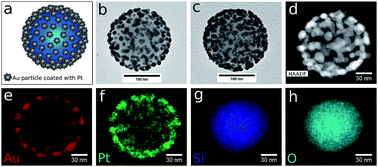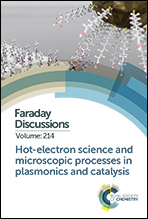Optimizing hot carrier effects in Pt-decorated plasmonic heterostructures
Abstract
Hot carrier generation by light in various semiconductors and metallic nanostructures is important for many photocatalytic and photochemical processes, including water and hydrogen splitting. Here, we report on investigations of hot electron generation and extraction from Pt decorated SiO2–Au nanoparticles using the degradation of methylene blue dye as a test-bed. Enhanced catalytic activity was found with an increase of Pt loading on the surface of the heterostructures. The small size of the Au nanoparticles (∼12 nm) decorating the silica nanoparticles reduces hot electron collisions and related thermalization processes, since charge carriers have short paths to the surface where reactions take place and where Pt is situated. The heterostructures exhibit a broad plasmonic resonance in the visible wavelength range from 500 to 700 nm and hot carrier generation predominately takes place under resonant excitation. Electron-microscopy characterization and numerical modelling have allowed the optimization of Pt coverage for hot-electron transfer, consisting of a thin Pt shell covering the Au nanoparticle with Pt nanoparticles additionally placed on top. This geometry provides an increased number of active sites for methylene blue degradation and promotes separation of charge carriers generated by plasmonic excitations in Au. Such SiO2–Au–Pt nanoparticles are attractive for hot-electron production due to the tunability of their plasmonic resonance and enhanced catalytic activity.

- This article is part of the themed collection: Hot-electron science and microscopic processes in plasmonics and catalysis


 Please wait while we load your content...
Please wait while we load your content...